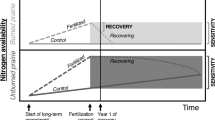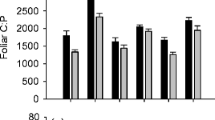Abstract
In the prolonged absence of major disturbances, ecosystems may enter a stage of retrogression, which is characterized by decreased ecosystem process rates both above and belowground, and often reduced availability of phosphorus (P). Disturbance through wildfire can increase soil P losses through leaching or erosion, but in the long-term absence of fire, soil P could potentially become increasingly bound in more stable forms that are less available to microbes. We studied forms of P and microbial respiration kinetics in the humus layer of a group of islands that vary considerably in wildfire frequency (40–5,300 years since last fire), and which are known to enter retrogression in the prolonged absence of fire. We found a decrease in labile P with decreasing fire frequency but no change in total P. Soil microorganisms responded more strongly to N than to P addition, and microbial biomass N:P ratios remained unchanged across the gradient. However, the concentration of labile P was the best predictor of microbial respiration responses across the islands, and this provides some evidence that declining access to P could contribute to the decline in soil microbial activity during retrogression. Our results show that even though N is arguably the main limiting nutrient during retrogression in this chronosequence, long term absence of fire also causes a decline in P availability which negatively affects microbial activity. This in turn could potentially impair microbially driven processes such as decomposition and mineralization and further contribute to the reduced availability of soil nutrients during retrogression.






Similar content being viewed by others
References
Akselsson C, Westling O, Alveteg M, Thelin G, Fransson AM, Hellsten S (2008) The influence of N load and harvest intensity on the risk of P limitation in Swedish forest soils. Sci Total Environ 404:284–289. doi:10.1016/j.scitotenv.2007.11.017
Allison VJ, Condron LM, Peltzer DA, Richardson SJ, Turner BL (2007) Changes in enzyme activities and soil microbial community composition along carbon and nutrient gradients along the Franz Josef chronosequence, New Zealand. Soil Biol Biochem 39:1770–1781. doi:10.1016/j.soilbio.2007.02.006
Anderson JPE, Domsch KHA (1978) A physiological method for the quantitative measurement of microbial biomass in soils. Soil Biol Biochem 10:215–221. doi:10.1016/0038-0717(78)90099-8
Attiwill PM, Adams MA (1993) Nutrient cycling in forests. New Phytol 124:561–582. doi:10.1111/j.1469-8137.1993.tb03847.x
Bayley SE, Schindler DW, Beaty KG, Parker BR, Stainton MP (1992) Effects of multiple fires on nutrient yields from streams draining boreal forest and fen watersheds—nitrogen and phosphorus. Can J Fish Aquat Sci 49:584–596. doi:10.1139/f92-068
Binkley D, Giardina C, Bashkin MA (2000) Soil phosphorus pools and supply under the influence of Eucaluptus saligna and nitrogen-fixing Albizia facaltaria. For Ecol Manage 128:241–247. doi:10.1016/S0378-1127(99)00138-3
Brookes PC, Powlson DS, Jenkinson DS (1982) Measurement of microbial biomass phosphorus in soil. Soil Biol Biochem 14:319–329. doi:10.1016/0038-0717(82)90001-3
Burke JM, Prepas EE, Pinder S (2005) Runoff and phosphorus export patterns in large forested watersheds on the western Canadian Boreal Plain before and for 4 years after wildfire. J Environ Eng Sci 4:319–325. doi:10.1139/s04-072
Chapin FS, Matson PA, Mooney HA (2002) Principles of terrestrial ecosystem ecology. Springer, New York
Cleveland CC, Liptzin D (2007) C:N:P stoichiometry in soil: is there a “Redfield ratio” for the microbial biomass? Biogeochem 85:235–252. doi:10.1007/s10533-007-9132-0
Coomes DA, Allen RB, Bentley WA, Burrows LE, Canham CD, Fagan L, Forsyth DM, Gaxiola-Alcantar A, Parfitt RL, Ruscoe WA, Wardle DA, Wilson DJ, Wrights EF (2005) The hare, the tortoise and the crocodile: the ecology of angiosperm dominance, conifer persistence and fern filtering. J Ecol 93:918–935. doi:10.1111/j.1365-2745.2005.01012.x
Crews TE, Kityama K, Fownes JH, Riley RH, Herbert DA, Mueller-Dombois D, Vitousek PM (1995) Changes in soil phosphorus fractions and ecosystem dynamics across a long chronosequence in Hawaii. Ecology 76:1407–1424. doi:10.2307/1938144
Crews TE, Farrington H, Vitousek PM (2000) Changes in asymbiotic, heterotrophic nitrogen fixation on leaf litter of Meterosideros polymorpha with long-term ecosystem development in Hawaii. Ecosyst 3:386–395. doi:10.1007/s100210000034
Cross AF, Schlesinger WH (1995) A literature-review and evaluation of the Hedley fractionation-applications to the biogeochemical cycle of soil-phosphorus in natural ecosystems. Geoderma 64:197–214. doi:10.1016/0016-7061(94)00023-4
Daly BK, Wainiqolo JL (1993) Methods of analysis for agricultural samples: soil, plant, animal feed and water. Fiji Agricultural Chemistry Laboratory Tech Report 03/93:115
Demetz M, Insam H (1999) Phosphorus availability in a forest soil determined with a respiratory assay compared to chemical methods. Geoderma 89:259–271. doi:10.1016/S0016-7061(98)00090-1
Ekblad A, Nordgren A (2002) Is growth of soil microorganisms in boreal forests limited by carbon or nitrogen availability? Plant Soil 242:115–122. doi:10.1023/A:1019698108838
Fang CM, Moncrieff JB (2005) The variation of soil microbial respiration with depth in relation to soil carbon composition. Plant Soil 268:243–253. doi:10.1007/s11104-004-0278-4
Freese D, Vanderzee SEATM, Vanriemsdijk WH (1992) Comparison of different models for phosphate sorption as a function of the iron and aluminium-oxides of soils. J Soil Sci 43:729–738. doi:10.1111/j.1365-2389.1992.tb00172.x
Giesler R, Satoh F, Ilstedt U, Nordgren A (2004) Microbially available phosphorus in boreal forests: effects of aluminium and iron in the humus layer. Ecosyst 7:208–217
Gnankambary Z, Ilstedt U, Nyberg G, Hien V, Malmer A (2007) Nitrogen and phosphorus limitation of soil microbial respiration in two tropical agroforestry parklands in the south-Sudanese zone of Burkina Faso: the effects of tree canopy and fertilization. Soil Biol Biochem 40:350–359. doi:10.1016/j.soilbio.2007.08.015
Güsewell S (2004) N:P ratios in terrestrial plants: variation and functional significance. New Phytol 164:243–266. doi:10.1111/j.1469-8137.2004.01192.x
Hedley MJ, Stewart JWB (1982) Method to measure microbial phosphate in soils. Soil Biol Biochem 14:377–385. doi:10.1016/0038-0717(82)90009-8
Hedley MJ, Stewart JWB, Chauhan BS (1982) Changes in inorganic and organic phosphorus fractions induced by cultivation practices and by laboratory incubation. Soil Sci Soc Am J 46:970–976
Hoffland E, Giesler R, Jongmans T, van Breemen N (2002) Increasing feldspar tunnelling by fungi across a north Sweden podzol chronosequence. Ecosyst 5:11.22
Ilstedt U, Singh S (2005) Nitrogen and phosphorus limitations of microbial respiration in a tropical phosphorus-fixing acrisol (ultisol) compared with organic compost. Soil Biol Biochem 37:1407–1410. doi:10.1016/j.soilbio.2005.01.002
Ilstedt U, Nordgren A, Malmer A (2000) Optimum soil water for soil respiration before and after amendment with glucose in humid tropical acrisols and a boreal mor layer. Soil Biol Biochem 32:1591–1599. doi:10.1016/S0038-0717(00)00073-0
Ilstedt U, Giesler R, Nordgren A, Malmer A (2003) Changes in soil chemical and microbial properties after a wildfire in a tropical rainforest in Sabah, Malaysia. Soil Biol Biochem 35:1071–1078. doi:10.1016/S0038-0717(03)00152-4
Jenkinson DS (1988) Determination of microbial biomass carbon and nitrogen in soil. In: Wilson JR (ed) Advances in nitrogen cycling in agricultural ecosystems. CAB International, Wallingford, pp 368–386
Kaspari M, Garcia MN, Harms KE, Santana M, Wright SJ, Yavitt JB (2008) Multiple nutrients limit litterfall and decomposition in a tropical forest. Ecol Lett 11:35–43
Koerselman W, Meuleman AFM (1996) The vegetation N:P ratio: a new tool to detect the nature of nutrient limitation. J Appl Ecol 33:1441–1450. doi:10.2307/2404783
Lagerström A, Nilsson M-C, Zackrisson O, Wardle DA (2007) Ecosystem input of nitrogen through biological fixation in feather mosses during ecosystem retrogression. Funct Ecol 21:1027–1033. doi:10.1111/j.1365-2435.2007.01331.x
Lecomte N, Simard M, Fenton N, Bergeron Y (2006) Fire severity and long-term ecosystem biomass dynamics in coniferous boreal forests of eastern Canada. Ecosyst 9:1215–1230. doi:10.1007/s10021-004-0168-x
McColl JG, Grigal DF (1975) Forest fire—effects on phosphorus movement to lakes. Science 188:1109–1111. doi:10.1126/science.188.4193.1109
Neff JC, Harden JW, Gleixner G (2005) Fire effects on soil organic matter content, composition, and nutrients in boreal interior Alaska. Can J For Res 35:2178–2187. doi:10.1139/x05-154
Niklasson M, Granström A (2000) Numbers and sized of fires: long-term spatially explicit fire history in a Swedish boreal landscape. Ecology 81:1484–1499
Nordgren A (1988) Apparatus for the continuous, long-term monitoring of soil respiration rate in large numbers of samples. Soil Biol Biochem 20:955–957. doi:10.1016/0038-0717(88)90110-1
Nordgren A (1992) A method for determining microbially available N and P in an organic soil. Biol Fertil Soils 13:195–199. doi:10.1007/BF00340575
Parfitt RL, Ross DJ, Coomes DA, Richardson SJ, Smale MC, Dahlgren RA (2005) N and P in New Zealand chronosequences and Relationships with foliar N and P. Biogeochem 75:305–328. doi:10.1007/s10533-004-7790-8
Prepas EE, Burke JM, Chanasyk DS, Smith DW, Putz G, Gabos S, Chen W, Millions D, Serediak M (2003) Impact of wildfire on discharge and phosphorus export from the Sakwatamau watershed in the Swan Hills, Alberta, during the first two years. J Environ Eng Sci 2:63–72. doi:10.1139/s03-036
Rees M, Condit R, Crawley M, Pacala S, Tilman D (2001) Long-term studies of vegetation dynamics. Science 293:650–655. doi:10.1126/science.1062586
Reich PB, Oleksyn J (2004) Global patterns of plant leaf N and P in relation to temperature and latitude. Proc Natl Acad Sci USA 101:11001–11006. doi:10.1073/pnas.0403588101
Richardson SJ, Pelzer DA, Allen RB, McGlone MS, Parfitt RL (2004) Rapid development of phosphorus limitation in temperate rainforest along the Franz Josef soil chronosequence. Oecologia 139:267–276. doi:10.1007/s00442-004-1501-y
Ross DJ (1992) Influence of sieve mesh size on estimates of microbial carbon and nitrogen by fumigation-extraction procedures in soils under pasture. Soil Biol Biochem 24:343–350. doi:10.1016/0038-0717(92)90194-3
Saggar S, Hedley MJ, White RE (1990) A simplified resin membrane technique for extracting phosphorus from soils. Fert Res 24:173–180. doi:10.1007/BF01073586
Sparling GP (1994) Manual of methods to estimate soil microbial biomass and activity. Internal report for The Grains Research and Development Corporation, Western Australia
Spencer CN, Hauer FR (1991) Phosphorus and nitrogen dynamics in streams during a wildfire. J N Am Benthol Soc 10:24–30. doi:10.2307/1467761
Starr MR (1991) Soil formation and fertility along a 5,000 years chronosequence. In: Pulkkinen E (ed) Environmental geochemistry in northern Europe. Geological Survey of Finland, Special Paper 9, pp 99–104
Turner BL, Condron LM, Richardson SJ, Peltzer DA, Allison VJ (2007) Soil organic phosphorus transformations during pedogenesis. Ecosyst 10:1166–1181. doi:10.1007/s10021-007-9086-z
Vance ED, Brookes PC, Jenkinson DS (1987) An extraction method for measuring soil microbial biomass C. Soil Biol Biochem 19:703–707. doi:10.1016/0038-0717(87)90052-6
Vesterdal L (1998) Potential microbial nitrogen and phosphorus availability in forest floors. Soil Biol Biochem 30:2031–2041. doi:10.1016/S0038-0717(98)00078-9
Vitousek PM (2002) Nutrient cycling and limitation. Hawaii as a model system. Princeton University Press, Princeton
Vitousek PM, Farrington H (1997) Nutrient limitation and soil development: experimental test of a biogeochemical theory. Biogeochem 37:63–75. doi:10.1023/A:1005757218475
Walker LR, del Moral R (2003) Primary succession and ecosystem rehabilitation. Cambridge University Press, Cambridge
Walker J, Reddell P (2007) Retrogressive succession and the restoration of old landscapes. In: Walker LR, Walker J, Hobbs RJ (eds) Linking restoration and ecosystem retrogression. Springer, New York, pp 69–89
Walker TW, Syers JK (1976) The fate of phosphorus during pedogenesis. Geoderma 15:1–19. doi:10.1016/0016-7061(76)90066-5
Walker J, Thompson CH, Jehne W (1983) Soil weathering stage, vegetation succession and canopy dieback. Pac Sci 37:471–481
Walker J, Thompson CH, Reddel P, Rapport DJ (2001) The importance of landscape age in influencing landscape health. Ecosyst Health 7:7–14. doi:10.1046/j.1526-0992.2001.007001007.x
Wardle DA, Zackrisson O (2005) Effects of species and functional group loss on island ecosystem properties. Nature 435:806–810. doi:10.1038/nature03611
Wardle DA, Zackrisson O, Hörnberg G, Gallet C (1997) The influence of island area on ecosystem properties. Science 277:1296–1299. doi:10.1126/science.277.5330.1296
Wardle DA, Hörnberg G, Zackrisson O, Kalela-Brundin M, Coomes DA (2003) Long-term effects of wildfire on ecosystem properties across an island area gradient. Science 300:972–975. doi:10.1126/science.1082709
Wardle DA, Walker LR, Bardgett DR (2004a) Ecosystem properties and forest decline in contrasting long-term chronosequences. Science 305:509–513. doi:10.1126/science.1098778
Wardle DA, Bardgett RD, Klironomos JN, Setälä H, van der Putten WH, Wall DH (2004b) Ecological linkages between aboveground and belowground biota. Science 304:1629–1633. doi:10.1126/science.1094875
Williamson WM, Wardle DA, Yeates GW (2005) Changes in soil microbial nematode communities during ecosystem decline across a long-term chronosequence. Soil Biol Biochem 37:1289–1301. doi:10.1016/j.soilbio.2004.11.025
Wood T, Bormann FH, Voigt GK (1984) Phosphorus cycling in a northern hardwood forest–biological and chemical control. Science 223:391–393. doi:10.1126/science.223.4634.391
Zackrisson O (1977) Influence of forest fires on the North Swedish boreal forest. Oikos 29:22–32. doi:10.2307/3543289
Acknowledgments
This study was part of the PhD thesis research of both C. Esberg and A. Lagerström. The authors thank Thomas Westin for laboratory assistance. We are grateful to Michael Gundale and Ulrik Ilstedt for providing helpful comments on earlier versions of the article. This work was supported by a grant from FORMAS to D. A. Wardle.
Author information
Authors and Affiliations
Corresponding author
Rights and permissions
About this article
Cite this article
Lagerström, A., Esberg, C., Wardle, D.A. et al. Soil phosphorus and microbial response to a long-term wildfire chronosequence in northern Sweden. Biogeochemistry 95, 199–213 (2009). https://doi.org/10.1007/s10533-009-9331-y
Received:
Accepted:
Published:
Issue Date:
DOI: https://doi.org/10.1007/s10533-009-9331-y




